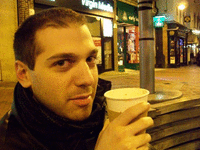
Ioannis Moupagiatzis M. Sc.
Alumnus of the Pattern Recognition Lab of the Friedrich-Alexander-Universität Erlangen-Nürnberg

Glaucoma, which is the second leading cause of blindness worldwide, is characterised by damage of the optic nerve. The patient cannot realise his problem until this damage is very severe (25%-40% of the optic nerve’s axons are destroyed before any field loss is measurable). This fact makes the early detection of this irreversible disease very important. There are several changes in the geometry of the optic nerve head caused by the destruction of the optic nerve (e.g. larger cup to disk ratio, because the optic cup sinks and expands). Optical Coherence Tomography (OCT) is a relatively new imaging modality that offers imaging of tissues at the histological level. OCT is the optical analogous of ultrasound imaging, but using light instead of ultrasounds is beneficial because the shorter wavelengths allow much higher resolution. The micrometer-level resolution that it offers can be used for the accurate extraction of the shape of the optic nerve head. After the acquisition of the OCT images, Computer Science can offer great benefits. The application of suitable image processing algorithms can lead to the accurate and automatic extraction of quantified information of the most important optic nerve head’s geometrical parameters. This will make the process much less dependent on the subjective and manual marking of the various regions of interest. Ultimately, these algorithms can be incorporated in a system that automatically detects glaucoma by examining OCT images.




